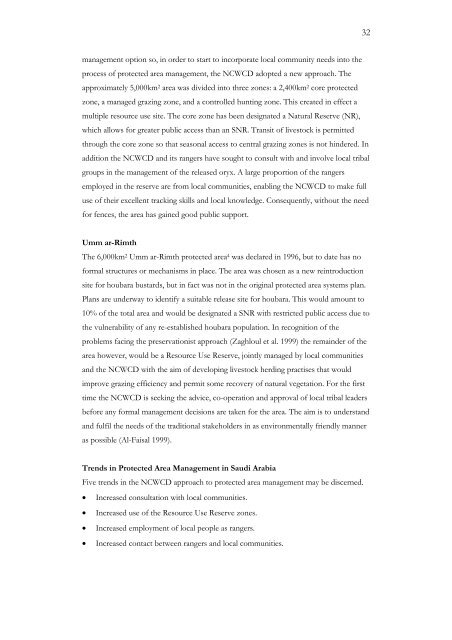The Unfenced Desert Towards a strategy for eco ... - Nwrc.gov.sa
The Unfenced Desert Towards a strategy for eco ... - Nwrc.gov.sa
The Unfenced Desert Towards a strategy for eco ... - Nwrc.gov.sa
Create successful ePaper yourself
Turn your PDF publications into a flip-book with our unique Google optimized e-Paper software.
management option so, in order to start to incorporate local community needs into the<br />
process of protected area management, the NCWCD adopted a new approach. <strong>The</strong><br />
approximately 5,000km2 area was divided into three zones: a 2,400km2 core protected<br />
zone, a managed grazing zone, and a controlled hunting zone. This created in effect a<br />
multiple resource use site. <strong>The</strong> core zone has been designated a Natural Reserve (NR),<br />
which allows <strong>for</strong> greater public access than an SNR. Transit of livestock is permitted<br />
through the core zone so that seasonal access to central grazing zones is not hindered. In<br />
addition the NCWCD and its rangers have sought to consult with and involve local tribal<br />
groups in the management of the released oryx. A large proportion of the rangers<br />
employed in the reserve are from local communities, enabling the NCWCD to make full<br />
use of their excellent tracking skills and local knowledge. Consequently, without the need<br />
<strong>for</strong> fences, the area has gained good public support.<br />
Umm ar-Rimth<br />
<strong>The</strong> 6,000km2 Umm ar-Rimth protected area4 was declared in 1996, but to date has no<br />
<strong>for</strong>mal structures or mechanisms in place. <strong>The</strong> area was chosen as a new reintroduction<br />
site <strong>for</strong> houbara bustards, but in fact was not in the original protected area systems plan.<br />
Plans are underway to identify a suitable release site <strong>for</strong> houbara. This would amount to<br />
10% of the total area and would be designated a SNR with restricted public access due to<br />
the vulnerability of any re-established houbara population. In r<strong>eco</strong>gnition of the<br />
problems facing the preservationist approach (Zaghloul et al. 1999) the remainder of the<br />
area however, would be a Resource Use Reserve, jointly managed by local communities<br />
and the NCWCD with the aim of developing livestock herding practises that would<br />
improve grazing efficiency and permit some r<strong>eco</strong>very of natural vegetation. For the first<br />
time the NCWCD is seeking the advice, co-operation and approval of local tribal leaders<br />
be<strong>for</strong>e any <strong>for</strong>mal management decisions are taken <strong>for</strong> the area. <strong>The</strong> aim is to understand<br />
and fulfil the needs of the traditional stakeholders in as environmentally friendly manner<br />
as possible (Al-Fai<strong>sa</strong>l 1999).<br />
Trends in Protected Area Management in Saudi Arabia<br />
Five trends in the NCWCD approach to protected area management may be discerned.<br />
• Increased consultation with local communities.<br />
• Increased use of the Resource Use Reserve zones.<br />
• Increased employment of local people as rangers.<br />
• Increased contact between rangers and local communities.<br />
32

















